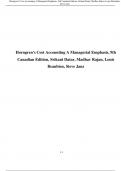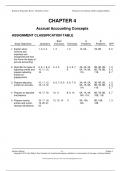Examen
Horngren's Cost Accounting A Managerial Emphasis, 9th Canadian Edition, Srikant Datar, Madhav Rajan, Louis Beaubien, Steve Janz All Chapter A+
- Grado
- Institución
Horngren's Cost Accounting A Managerial Emphasis, 9th Canadian Edition, Srikant Datar, Madhav Rajan, Louis Beaubien, Steve Janz All Chapter A+
[Mostrar más]




